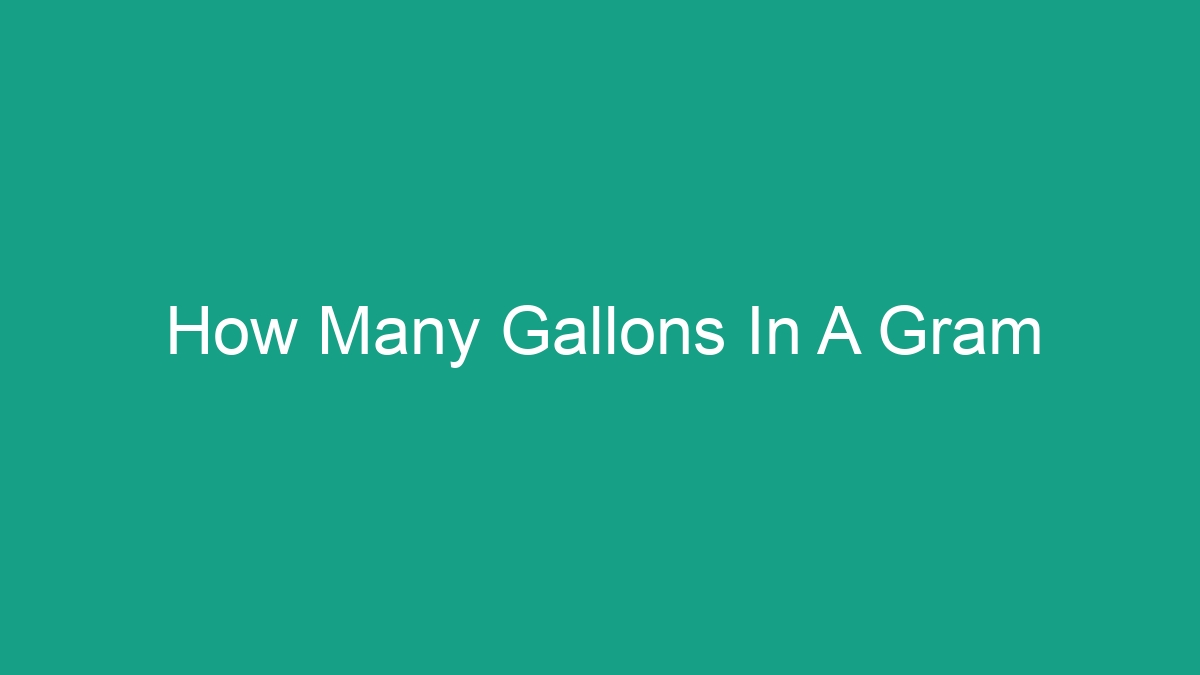
When dealing with measurements and conversions, it’s important to understand the relationship between different units of measurement. In this article, we will explore the conversion between gallons and grams, two common units used in different fields such as cooking, chemistry, and everyday household tasks.
The Gallon and Gram Units
Before diving into the conversion, let’s first understand what each unit represents.
- Gallon: The gallon is a unit of volume used in the imperial and United States customary systems of measurement. In the US, one gallon is equal to 128 fluid ounces or approximately 3.785 liters.
- Gram: The gram is a metric unit of mass. It is commonly used for measuring the weight of small items such as food ingredients and substances. One gram is equal to 0.03527396 ounces.
Converting Gallons to Grams
As we know, gallons measure volume, while grams measure mass. In order to convert between the two, we need to consider the density of the substance being measured. Density is the measure of mass per unit of volume, and it varies depending on the substance.
For example, the density of water at 4 degrees Celsius is 1 gram per milliliter, or 1,000 grams per liter. This means that 1 liter of water weighs 1,000 grams. With this information, we can calculate the number of grams in a gallon of water:
| 1 gallon of water | 3.785 liters |
|---|---|
| x 1,000 grams per liter |
By performing the calculation, we find that 1 gallon of water is equivalent to 3,785 grams.
Common Conversions
Here are some common conversions for various substances:
- Milk: The density of milk is approximately 1.03 grams per milliliter. Therefore, 1 gallon of milk is approximately 3,895 grams.
- Gasoline: The density of gasoline can vary, but on average, it is around 0.74 grams per milliliter. This means that 1 gallon of gasoline is approximately 2,798 grams.
- Sugar: Granulated sugar has a density of about 0.85 grams per milliliter. Therefore, 1 gallon of sugar weighs approximately 3,217 grams.
Frequently Asked Questions
1. Can grams be converted directly to gallons?
No, grams and gallons measure different properties. Grams measure mass, while gallons measure volume. In order to convert between the two, the density of the substance must be taken into account.
2. Why is it important to understand the relationship between gallons and grams?
Understanding the conversion between gallons and grams is important for various applications. For example, in cooking and baking, recipes may list ingredients in either volume (cups, tablespoons) or weight (grams, ounces). Knowing the conversion allows for accurate measurement and consistent results.
3. Is there a universal conversion factor for all substances?
No, the conversion factor between gallons and grams varies depending on the density of the substance being measured. Different substances have different densities, so the conversion factor will be different for each one.
4. How can I convert between gallons and grams for a specific substance?
To convert between gallons and grams for a specific substance, you will need to know the density of that substance. Once you have the density, you can use the following formula:
Gallons x Density (grams per milliliter) x 3,785 (conversion factor for liters to gallons)
For example, if you want to convert 2 gallons of milk to grams, and the density of milk is 1.03 grams per milliliter:
2 gallons x 1.03 grams/ml x 3,785 ml
By performing the calculation, you can determine the number of grams in 2 gallons of milk.
5. Are there any online tools or calculators for converting between gallons and grams?
Yes, there are many online conversion tools and calculators that can help you convert between different units of measurement, including gallons and grams. Simply input the value you want to convert and select the units, and the tool will provide you with the equivalent value in the desired unit.
Overall, understanding the conversion between gallons and grams is essential for various tasks, from cooking and baking to scientific experiments. By considering the density of the substance being measured, you can accurately convert between these two units and ensure precise measurements in your activities.



